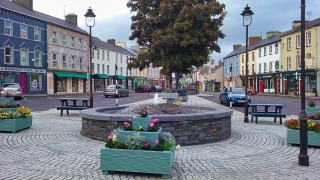
Dunmanway
Dunmanway is a small but busy market town in the valley of the Bandon River, full of character and charm and with a diverse choice of things to see and do. It is just 45 minutes from both Killarney and Cork City, making it an ideal touring base.
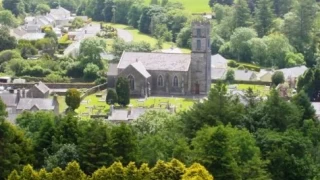
DIRECTIONS
Located on the R586, about 60km west of Cork city, 35km from Bantry and 23km from Clonakilty.
SPECIAL AREAS OF CONSERVATION
Bandon River valley
About
Dunmanway has a colourful history and a range of activities for visitors. The town is encompassed by spectacular scenery, with hills and lakes to the North, South and West and can lay claim to being “The Gateway to The Mountains”. As such it is ideal for hill walking, kayaking, fishing, cycling and horse-riding.
The local recreational grounds boast a 25 metre public swimming pool, an 18-hole pitch and putt course, children’s’ playground, tennis courts, an astro turf soccer pitch and an outdoor gym. Like other parts of County Cork, road bowling is a popular sport in the surrounding area, and the All-Ireland road bowling championships took place in Dunmanway in July 2011.
Dunmanway information courtesy of www.dunmanway.ie and Tommy Collins.
History
Dunmanway is a 17th century planned town and the original two triangular squares still survive. Various sources list its meaning when translated from Irish as “the castle of the yellow river,” “the castle on the little plain,” “the fort of the gables (or pinnacles),” and “the fort of the yellow women.” It is best known as the birthplace of Sam Maguire, the man for whom the All Ireland Senior Football trophy is named.
Sam Maguire 1877-1927
Sam Maguire was born in 1877 in the townland of Mallabracka, near Dunmanway, where the Maguires farmed 200 acres of land. They were members of the Church of Ireland but mixed freely with protestants and catholics. Sam attended the Model School, Bantry Road, Dunmanway and afterwards the Ardfield National School near Clonakilty, which was also attended by Michael Collins.
The period 1890 to 1900 was one of National Revival. While working in the Civil Service in London Sam joined and captained the London Hibernian Gaelic Football team to three All-Ireland finals. On finishing his playing career Sam became Chairman of the London County Board and later a trustee of Croke Park, the national Gaelic Games playing grounds in Dublin. He returned to Dublin in 1921 and was employed in the newly established Irish Civil Service while also working tirelessly for the Gaelic Games Association (GAA).

Sam returned to Dunmanway where he died of tuberculosis on February 6th 1927 at the age of 49. He is buried in St. Mary’s Church of Ireland graveyard. A tall and ornate Celtic Cross erected in 1941, marks the spot where he is buried and the inscription reads, “Erected to the memory of Samuel Maguire of Mallabracka who died on Feb 6th 1927 by the people of Dunmanway and his numerous friends throughout Ireland and England in recognition of his love for his country.
Every September in Croke Park, Dublin, the captain of the winning team in the All-Ireland Senior Football Championship lifts the Sam Maguire Cup to a huge roar from the crowd. The name of Sam Maguire has, through the Gaelic Games, become synonymous with Irish culture. He saw in the GAA a vehicle by which expression and positive support could be given to the establishment of Ireland as an independent nation with its own cultural identity. The Sam Maguire Cup ensures that the memory of this great man lives on.
The Sam Maguire Cup
Shortly after his death a number of his friends came together to decide how best his memory could be perpetuated. The Sam Maguire Cup was commissioned and was wrought by Hopkins and Hopkins, Dublin to the design of the Ardagh Chalice. The first recipient of the Sam Maguire trophy was the Kildare captain Bill Gannon in 1928. The trophy was a regular visitor to Dunmanway, especially in 1945, 1973, 1989 and 1990 when Cork were champions and in 1960 when Down footballers visited the old Maguire homestead. The cup was last in Dunmanway in 1987 after which the GAA authorities recalled it to Croke Park in Dublin and replaced it with an identical replica. The original trophy is on permanent display in the GAA Museum in Croke Park.
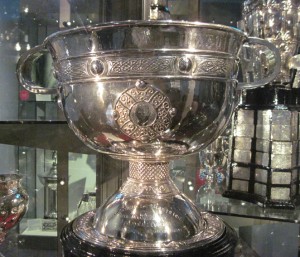
Birthplace
Four miles to the north of the town of Dunmanway a great silent valley runs westwards to the Cousane Gap. It is a place of wild beauty, with Nowen Hill rising majestically to the west, the Yew Tree Hill towering to the south and the Shehy Mountains stretching northwards into the distance. Here in the townland of Mallabracka lies the homestead of the Maguire family where Sam Maguire was born and grew up. Just a short distance from his homestead a monument was erected in 1984 to mark the location of his birthplace.
Ballabuidhe Horse Fair
The origins of the Ballabuidhe Horse Fair and Races, which is held at the beginning of August each year, are lost in antiquity, with written records only going back to 1615. To the present day, Ballabuidhe Fair carries on the ancient tradition of great fairs like Tara and Tailte, incorporating horse racing, selling and buying of wares, and the display of fine horses for sale.
Ballabuidhe Races comprise over thirty races of which about half are trotting and sulky. The rest are flat races for ponies and horses, specially bred for speed and agility. These are not only exciting for the spectator, but have proved a valuable training ground for aspiring jockeys.
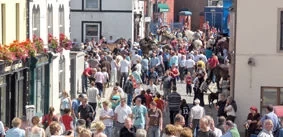
Trotting horses are not new to Ireland; they were introduced to England early in the eleventh century. It can be assumed that they came to Ireland with the Normans. As by the fifteenth century, Irish pacing horses or ‘hobbies’ were famous in England for their speed and success in races. In recent years, registration of trotters and pacers, drivers and jockeys have increased annually.
After three days of racing, the famous old Ballabuidhe Horse Fair is held, and in conjunction with it, a Horse Show. Held on the streets, it is the only one of its kind in the country.
Dunmanway Versus Liverpool FC
The local soccer club is Dunmanway Town, who play in the Premier Division of the West Cork League. In June 2009, it was sensationally announced that the world famous Liverpool F.C. had agreed to visit Dunmanway to play Town in a pre-season friendly on 6 August 2009.Liverpool, fielding players from their reserve and youth teams (the home side supplemented their line-up with a number of players from prominent Cork-based clubs like Avondale United and Cobh Ramblers) won the game by one goal to nil in front of 6,800 fans, and Gardaí estimated that more than 15,000 people visited Dunmanway on the day to catch a glimpse of the Liverpool stars of the future.
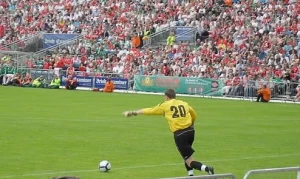
Things to do
Dunmanway Heritage Centre
Dunmanway Heritage Centre is located on the Main Street and features presentations on diverse subjects including Sam Maguire, The Great Famine and The Model School. You will also find information on the four castles in the area – the MacCarthy Castles at Dunmanway and Togher as well as the Randal Og Hurley Castle at Ballinacarriga and the Crowley Castle at Ahakeera.
Also available at the centre is research on Archaeology in the locality including a register of headstones in Kilbarry and Fanlobbus graveyards.
The Heritage Centre offers helpful information and assistance to those seeking genealogy information covering the Dunmanway area. The 1901 and 1911 Census records as well as Griffith’s Valuation of 1852 are available as a valuable resource in genealogy research, and the staff at the heritage centre are always helpful in searching church records for the Dunmanway area.
School children are especially welcome to visit the centre to research school projects. The centre is open Monday to Thursday 9.30am – 3pm, Friday 11am – 1pm and 2pm – 4pm.
Walking & Hiking
There are several well-designed walks, from easy to hard, both in the town and to the north of Dunmanway. See also the Dunmanway Hill Walking Trails or Dunmanway Town Heritage Walks under the Walking section.
Mountain Biking
For adrenalin and keep fit junkies there are some of the best and most difficult mountain biking courses in Ireland just outside the town in Clashnacrona. This small compact forest is a must for the mountain bike enthusiast. Head out on the R586 towards Bantry for 2 miles and you will see Dunmanway forest trails are on your right.
Chapel Lake
Few other towns can boast of having a lake situated only a few hundred metres from the town centre. At the lakeside is a garden and picnic area for public use.
Fishing
Dunmanway boasts of some of the finest fresh water fishing in Cork. There are many rivers and lakes in the locality, which are perfect for the fishing enthusiast.
Free Lakes:
- Cullineagh – Trout
- Shiplake – Trout
- Ballinacarriga – Trout
- Curralickey – Bream, Pike, Rudd
Childrens Playground
Dunmanway has a wonderful spacious park, situated on the Bantry Road, which is well maintained and contains a fully equipped playground with Springers, Play Houses, Swings, Furniture, Sculptures, Sand and Water Play Multi-Play Units
The Manch Project
The Irish Natural Forestry Foundation (INFF) has established the Manch Project at Manch Estate near Ballineen. The project is designed to demonstrate sustainable establishment and management of broadleaved woodland and involves extending the original semi-native woodland, woodland restoration, field trial plots, riparian trial plots and hedgerow planting and management amongst other features.
The Education Centre runs a series of nature and wildlife courses for both children and adults and regular open days allow the public to explore up to 15 km of woodland paths. Manch lies just north of the main Bandon to Dunmanway road (R586), about 2 miles west of Ballineen and 5 miles east of Dunmanway.
